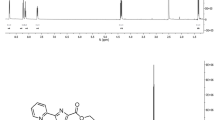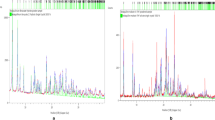Abstract
NPC 1161C is a novel antimalarial drug of interest because of its superior curative and prophylactic activity, and favorable toxicity profile against in vivo and in vitro models of malaria, pneumocystis carinii pneumonia, and leishmaniasis. The preformulation studies performed included determination of pKas, aqueous and pH solubility, cosolvent solubility, log P, pH stability, thermal analysis, and preliminary hygroscopicity studies. The mean pKa1, pKa2, and pKa3 were determined to be 10.12, 4.07, and 1.88, respectively. The aqueous solubility was found to be 2.4 × 10−4 M having a saturated solution pH of 4.3–5.0 and a low intrinsic solubility of 1.6 × 10−6 M. A mathematical model of the pH-solubility profile was derived from pH 2.2 to 8.0. An exponential decrease in solubility was observed with increasing pH. The excess solid phase in equilibrium with the solution in aqueous buffers was determined to be the free-base form of the drug. A significant increase in solubility was observed with all the cosolvents studied, in both unbuffered and buffered systems. Mean log P of the salt and the free base were estimated to be 2.18 and 3.70, respectively. The compound had poor stability at pH 7.0 at 37°C, with a t 90 of 3.58 days. Thermal analysis of the drug using DSC and TGA revealed that the drug is present as a semi-crystalline powder, which transformed into the amorphous state after melting. The drug was also found to sublime at higher temperatures. Determination of physicochemical properties of NPC 1161C provided useful information for the development of a dosage form and preclinical evaluation.















Similar content being viewed by others
References
McChesney J, Nanayakkara DN, Bartlett M, Ager AL. 8-Aminoquinolines. In US Patent 6,376,511 B2; 2002.
Wells JI. Pharmaceutical preformulation, the physicochemical properties of drug substances. Chichester: Ellis Horwood Limited; 1988. New York: Halsted Press, a Division of John Wiley & Sons.
Carstensen JT. Pharmaceutical preformulation. Lanchester: Technomic Publishing Company, Inc.; 1998.
Luner PE, Kirsch LE, Majuru S, Oh E, Joshi AB, Wurster DE, et al. Preformulation studies on the s-isomer of oxybutynin hydrochloride, an improved chemical entity (ICE™). Drug Dev Ind Pharm. 2001;27(4):321–9.
Dutta AK, Avery BA, Wyandt CM. Development and validation of a stability-indicating reversed phase high performance liquid chromatography method for NPC 1161C, a novel 8-aminoquinoline antimalarial drug. J Chromatogr A. 2006;1110:35–45.
Albert A, Serjeant EP. The determination of ionization constants, a laboratory manual. 3rd ed. New York: Chapman and Hall Ltd.; 1984.
Hurwitz AR, Liu ST. Determination of aqueous solubility and pKa values of estrogens. J Pharm Sci. 1977;66(5):624–7.
Martin A. Physical pharmacy. 4th ed. Philadelphia: Lea & Febiger; 1993.
McIlvaine TC. A buffer solution for colorimetric comparison. J Biol Chem. 1921;49:183–6.
Perrin DD, Dempsey B. Buffers for pH and metal ion control. London: Chapman Hall; 1974. p. 153. New York: John Wiley & Sons.
Yalkowsky SH. Solubility and solubilization in aqueous media. Washington: American Chemical Society; 1999. New York; Oxford: Oxford University Press.
United States Pharmacopoeia 23, The National Formulary 18. Maryland: United States Pharmacopeial Convention, Inc.; 1995. pp. 2049–50.
Shah JC, Chen JR, Chow D. Preformulation study of etoposide: identification of physicochemical characteristics responsible for the low and erratic oral bioavailability of etoposide. Pharm Res. 1989;6(5):408–12.
Garst JE, Wilson WC. Accurate wide-range, automated, high-performance liquid chromatographic method for the estimation of octanol/water partition coefficients I: effect of chromatographic conditions and procedure variables on accuracy and reproducibility of the method. J Pharm Sci. 1984;73(11):1616–23.
Slater B, McCormack A, Avdeef A, Comer JEA. pH-metric log P. 4. Comparison of partition coefficients determined by HPLC and potentiometric methods to literature values. J Pharm Sci. 1994;83(9):1280–3.
Snyder LR, Kirkland JJ, Glajch JL. Practical HPLC method development. New York: Wiley; 1997.
Griffin S, Wyllie SG, Markham J. Determination of octanol-water partition coefficient for terpenoids using reversed-phase high performance liquid chromatography. J Chromatogr A. 1999;864:221–8.
Moriguchi I, Hirono S, Liu Q, Nakagome I, Matsushita Y. Simple method of calculating octanol/water partition coefficient. Chem Pharm Bull. 1992;40:127–39.
Moriguchi I, Hirono S, Liu Q, Nakagome I, Hirano H. Comparison of reliability of LOG P values for drugs calculated by several methods. Chem Pharm Bull. 1994;42:976–8.
Sichina WJ. Solving tough industrial characterization problems with high performance DSC. Proc 29th Annu Conf N Am Therm Anal Soc. 2001;29:605–11.
Sichina WJ, Cassel RB. Enhanced characterization of materials using StepScan DSC. Proc 28th Annu Conf N Am Therm Anal Soc. 2000;4–6:158–66.
Saunders M, Podluii K, Shergill S, Buckton G, Royall P. The potential of high speed DSC (hyper-DSC) for the detection and quantification of small amounts of amorphous content in predominantly crystalline samples. Int J Pharm. 2004;274:35–40.
Lide DR. CRC Handbook of Chemistry and Physics. 78th ed. Cleveland: Chemical Publishing Company, Inc.; 1997. p. 15–24.
Bechalany A, Tsantili-Kakoulidou A, Tayar N, Testa B. Measurement of lipophilicity indices by reversed-phase high-performance liquid chromatography: comparison of two stationary phases and various eluents. J Chromatogr. 1991;541:221–9.
Calvino R, Fruttero R, Gasco A. Reversed-phase high-performance liquid chromatographic study of the lipophilicity of a series of analogues of the antibiotic “calvatic acid”. J Chromatogr. 1991;547:167–73.
Li S, Wong S, Sethia S, Almoazen H, Joshi YM, Serajuddin ATM. Investigation of solubility and dissolution of a free base and two different salt forms as a function of pH. Pharm Res. 2005;22(4):628–35.
Lipinski CA, Lombarbo F, Dominy BW, Feeney PJ. Experimental and computational approaches to estimate solubility and permeability in drug discovery and development settings. Adv Drug Deliv Rev. 2001;46(1–3):3–26.
Weast RC. CRC Handbook of Chemistry and Physics, 64th edn. Florida; CRC Press; 1983–84. pp. C689–90.
Acknowledgments
The authors wish to acknowledge National Center for Natural Products Research and Dr. Dhammika N. Nanayakkara for providing NPC 1161C samples. The authors also wish to thank Mr. Frank Wiggers of NCNPR for his technical assistance with NMR spectroscopy.
Author information
Authors and Affiliations
Corresponding author
Rights and permissions
About this article
Cite this article
Dutta, A.K., Stodghill, S.P. & Wyandt, C.M. Physicochemical Characterization of NPC 1161C, A Novel Antimalarial 8-Aminoquinoline, in Solution and Solid State. AAPS PharmSciTech 12, 177–191 (2011). https://doi.org/10.1208/s12249-010-9578-6
Received:
Accepted:
Published:
Issue Date:
DOI: https://doi.org/10.1208/s12249-010-9578-6




